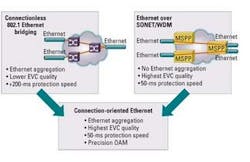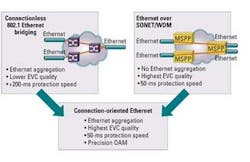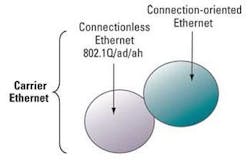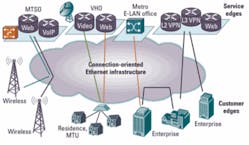By Sam Lisle
OVERVIEW
As service providers move away from TDM-based networking, the need remains for a universal aggregation and transport infrastructure that connects all types of end users to each other and to higher-layer services. Connection-oriented Ethernet meets this requirement.
Ethernet is revolutionizing metro networking. From enterprise services growing at double-digit percentages per year, to Ethernet-based triple-play transport infrastructures, to emerging Ethernet-based mobile backhaul applications, the success of service providers is increasingly dependent upon how effectively they deal with Ethernet.
As Ethernet plays an increasing role for mobile backhaul, enterprise services, growth in residential broadband, and as an access technology for IP services, network providers must be able to deploy a single, general-purpose Ethernet aggregation and transport environment for all these applications. This new infrastructure must deliver deterministic performance of Layer 1 transport along with the aggregation and statistical multiplexing economics of native Ethernet.
Connection-oriented Ethernet is the only technology that delivers these capabilities and completes the Ethernet revolution by accomplishing for Ethernet what SONET/SDH accomplished for TDM (see Fig. 1).
Ethernet has been connectionless by design. In LAN environments, connectionless MAC bridging and CSMA/CD have provided flexibility, simplicity, and economy in networking latency-insensitive traffic within a single, well-bounded administrative domain. To bring the cost and flexibility benefits of Ethernet into the public network, the industry has enhanced and extended classic Ethernet protocols to create “Carrier Ethernet.” Most of these enhancements have focused around extending connectionless bridging protocols to the service provider environment and have brought about new capabilities in:
- operations, administration, and maintenance (OAM; IEEE 802.1ag, IEEE 803.2ah, and ITU-T Y.1731)
- survivability (ITU-T G.8031, IEEE 802.3ad, and IEEE 802.1s)
- scalability (IEEE 802.1ad and IEEE 802.1ah)
- speed and distance (IEEE 802.3ae, et al.)
In addition to those standards, equipment vendors “beefed up” enterprise-class Ethernet hardware and software to provide a number of carrier-class reliability and operational features.
The next step forward is making Ethernet connection oriented. Connection-oriented Ethernet is a high-performance subset of Carrier Ethernet that is optimized for the point-to-point and point-to-multipoint connections that are the essential underpinnings of aggregation infrastructure (see Fig. 2).
The three essential functions that make Ethernet connection oriented are:
- specified Ethernet Virtual Circuit (EVC) paths
- resource reservation and admission control
- per-connection traffic management
Explicitly specifying the EVC path is fundamental to making Ethernet connection oriented. In connectionless Ethernet bridging, frames are forwarded in the network according to the MAC bridging tables in the learning bridge. If a destination MAC address is unknown, the bridge floods the frame to all ports in the broadcast domain. This behavior cannot be controlled by the operator, and therefore bridged networks cannot be completely traffic engineered. Spanning tree protocols are run to ensure there are no loops in the topology and to provide network restoration in the event of failure. Depending upon the location and sequence of network failures, the path that EVCs take through the network may be difficult to predetermine.
By specifying the EVC path -- either through a management plane application or via an embedded control plane -- and disabling the flooding/learning bridging behavior, all frames in the EVC are now ensured to pass over the same sets of nodes. Intelligence regarding the connection as a whole can now be imparted to all nodes along the path as well. This also opens the possibility for dedicated 50-msec protection switching using G.8031 or 802.1Qay.
Resource reservation and connection admission control (CAC) is the next critical function. Now that the EVC path through the network has been explicitly identified, the bandwidth and queuing resources that are required for each EVC are reserved in all nodes along the path. This ensures that packet loss, latency, and jitter performance are deterministic. CAC ensures that the requested resource is available in each node along the path prior to the establishment of the EVC.
- classification
- policing
- queuing
- scheduling
- shaping
The shaping, queuing, and scheduling granularity determines whether each EVC enjoys the benefits of connection-oriented Ethernet or is essentially connectionless from a performance point of view.
When an Ethernet frame awaits a transmission opportunity on an egress port, it is queued along with other connections also bound for the same egress port; a scheduler determines which frame goes next, and there is a shaping function. The critical question is how are these frames queued, scheduled, and shaped and at what level of granularity: per card? Per port? Per EVC connection? Per class of service (CoS) within an EVC?
On many Carrier Ethernet traffic management implementations, Ethernet frames from many EVCs are placed into a single set of egress queues per output port (or even per card) and the scheduler loses visibility to individual EVCs. When this happens, the network begins to play “priority roulette” where all EVCs in the same priority class receive first-come, first-served access to transmission opportunities and the service quality of individual connections is not deterministic (see Fig. 3a).
Only by providing policing, scheduling, and egress shaping functions down to the granularity of an individual class of service (CoS) within an EVC can the connection performance be guaranteed (see Fig. 3b).
By providing the three essential functions of predetermined EVC paths, resource reservation and admission control, and per-connection traffic engineering and traffic management, Ethernet connections can now enjoy a level of service quality that is on par with Ethernet over SONET/SDH along with the aggregation flexibility of native Ethernet.
There are several existing, retired, and emerging technologies that can realize connection-oriented Ethernet. These include:
- VLAN (S-tag + C-tag) tag switching
- 802.1Qay (PBB-TE)
- MPLS-TP
- T-MPLS (retired by the ITU)
- IP/MPLS
There are important considerations when choosing a connection-oriented Ethernet approach for metro aggregation and transport infrastructure:
- How many layers are required in the network?
- Is a routed IP data plane and associated complexity required?
Ethernet-only approaches such as VLAN tag switching and Provider Backbone Bridge-Traffic Engineering approaches do not require additional pseudowire or MPLS layers and are therefore simpler to integrate into operations support systems and require fewer layers of OAM for fault and performance management.
Ethernet-only approaches do not require the deployment of a software-intensive, IP-routed data plane deep into the metro aggregation network. This is vitally important because there are often thousands of remotely deployed elements in aggregation networks, and the introduction of an IP routed control plane greatly increases the complexity of software maintenance, troubleshooting, and provisioning as well as the operational cost of the network.
There are several important applications that will drive deployment of connection-oriented Ethernet. These include:
- wireline backhaul for 3G and 4G mobile wireless networks
- Ethernet infrastructure scaling
- TDM-quality Ethernet private-line services
- triple-play and residential broadband infrastructure
Some of these applications are discussed below.
Backhaul for 3G and 4G mobile wireless networks. Mobile providers are already or will soon be deploying WiMAX and Long Term Evolution (LTE) 4G wireless networks that specify Ethernet interfaces from the base station to the wireline network. Many mobile operators are also upgrading existing 3G base stations to Ethernet backhaul on an opportunity basis.
In a mobile backhaul network, there may be hundreds of cell towers, each bringing back Ethernet bandwidth that must be funneled down to a handful of ports at a set of mobile switching offices. This requires a large amount of Ethernet aggregation that does not compromise the strict latency and jitter requirements of voice and signaling applications, making connection-oriented Ethernet a must for these new networks. Connection-oriented Ethernet deployed in an optical backhaul network enables aggregation, provides network protection, transports legacy T1 needs in native form, and allocates resources for all the Ethernet connections while allowing oversubscription for the interactive and background applications.
Ethernet infrastructure scaling. As Ethernet networks grow, it becomes necessary to more efficiently interconnect traffic from many Ethernet sources to the IP service edge or to provide connectivity among embedded Ethernet-attached platforms.
Ethernet crossconnect machines with connection-oriented Ethernet provide a solid, scalable foundation for this interconnection function. The Ethernet crossconnect with a large-scale grooming fabric consolidates EVCs or VLANs from multiple Fast Ethernet and Gigabit Ethernet ports to highly filled 10-Gigabit Ethernet pipes and interconnect traffic efficiently among Ethernet access networks. The ability to flexibly manipulate, translate, and push/pop tags in this Ethernet crossconnect provides an incredible amount of networking and interconnection power. These platforms provide economic payback at fairly low levels of traffic and provide considerable management flexibility.
Because the Ethernet crossconnect uses connection-oriented Ethernet, the service-level agreement requirements for any type of service can be met or surpassed through the device. If connection-oriented Ethernet switching is integrated into the electronic switching fabric of a packet optical networking platform (PONP) that may already exist in the office for SONET/SDH grooming, then the Ethernet crossconnect common equipment cost is effectively eliminated and the service provider can derive an immediate economic benefit by deploying Ethernet grooming.
TDM-quality Ethernet private line services. The Metro Ethernet Forum (MEF) has defined Ethernet Private Line (EPL) and Ethernet Virtual Private Line (EVPL) services. EPL services have a single EVC connecting the ingress and egress ports across the network. EVPL services are more powerful because they support more than one EVC per port, enabling a single highly utilized Ethernet port at a central location to support multiple EVCs that connect to different remote locations.
When EVPL services are provided over connectionless Ethernet networks, the service quality is often not as good as with traditional TDM private-line circuits. This is because of the lack of resource reservation, the need to account for unexpected Ethernet flooding, and the reliance upon spanning tree protocols for restoration. In addition, connectionless Ethernet networks often place significant requirements and restrictions upon customer premises equipment (CPE). These restrictions include such items as requiring the CPE to shape traffic and limiting the amount of latency-sensitive traffic that can be introduced onto the network over a customer user-to-network interface.
Connection-oriented Ethernet technology delivers TDM-equivalent-quality EVPL services along with 50-msec protection switching, which removes all significant restrictions from the customer's CPE.
When connection-oriented Ethernet is integrated directly into the optical access environment in a PONP, there are additional cost savings by offloading EVPL services from already deployed E-LAN service platforms.
Service providers delivered enormously profitable TDM services by leveraging a single common aggregation and transport infrastructure based on connection-oriented SONET/SDH technology. As demand for Ethernet grows, and as service providers compete to provide higher-quality Ethernet networking for all applications, there is again a need for a universal aggregation and transport infrastructure that connects all types of end users to each other and to every type of higher-layer service (see Fig. 4).
A connection-oriented Ethernet aggregation infrastructure delivers the cost-effectiveness of statistical multiplexing and large-scale Ethernet aggregation and the performance quality and manageability of SONET/SDH. It allows service providers to most economically deliver the full range of network applications for mobile, enterprise, and residential users.
Sam Lisle is a market development director at Fujitsu Network Communications, where he focuses on packet optical networking technology and applications.
LINKS TO MORE INFORMATION
Lightwave:Where Should Network Intelligence Reside?
Lightwave:Packet Optical Networking Aids Metro Network Evolution
Lightwave:Carrier Ethernet Transport: No Longer 'If,' but 'How'




